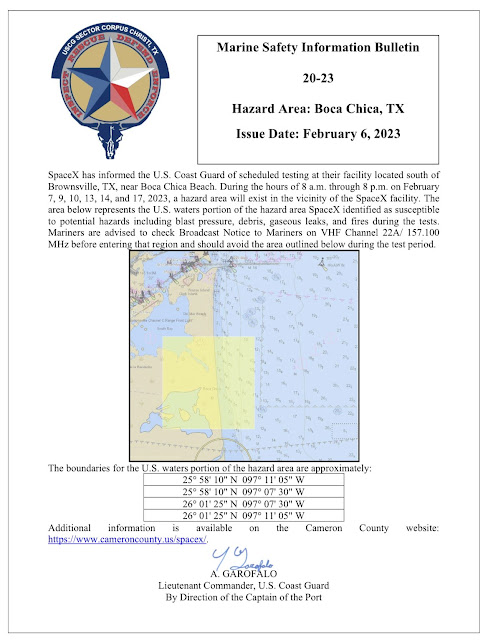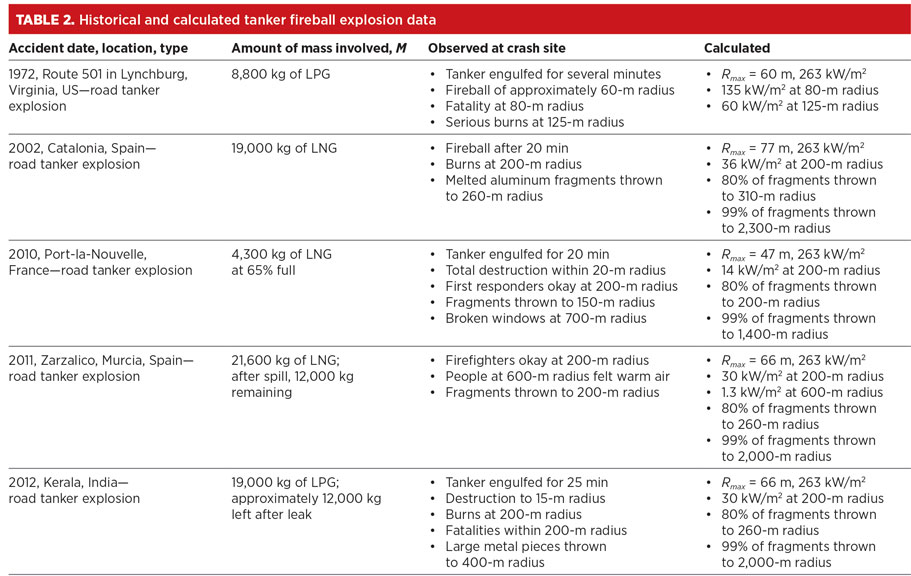Copyright 2023 Robert Clark
In the blog post, "SuperHeavy+Starship have the thermal energy of the Hiroshima bomb", I noted the SuperHeavy/Starship launch potentially can be damaging to people and property if it explodes.
I was using an exclusion radius though of only 2 miles, 3.2 km based on this hazard notice:
However, this FAA report on page 22 puts the exclusion zone around the launch pad at about 5 mile radius:
This is about about how far away Starship launch watchers are on South Padre Island when watching the launch from outside. It’s also the distance where space launch reporters such as Tim Dodd the “Everyday Astronaut” and others report on the Starship launches from hotel rooms on South Padre Island:
SpaceX Starship: Slo-mo SN9 flight video shows explosion in stunning detail SpaceX's Starship tackled its latest "hop test" — and it didn't end well.BY MIKE BROWN
FEB. 3, 2021. Ryan Chylinski, co-founder of Cosmic Perspective, tells Inverse he and his team were on a hotel balcony on South Padre Island during the launch — around five miles away. “We could certainly feel the rumble of the Raptors [the craft's engines] at this distance," he says. "And that explosion shockwave, wow!” he adds.
https://www.inverse.com/innovation/spacex-starship-sn9-flight
It's also uncomfortably close to the distance to Port Isabel, TX at 6 to 7 miles away, a town of about 5 thousand people.
However, even 5 miles is likely to still not be a safe distance based on other large explosions at the kiloton level such as the Texas City disaster:
April 16, 1947: Ship Explosion Ignites 3-Day Rain of Fire and Death.…It shattered all the windows in Texas City and half of those in Galveston, 10 miles away. Some debris reached an altitude of nearly 3 miles before falling back to earth. Two airplanes circling overhead were blown apart by the heavy shrapnel. A one-ton piece of the ship's propeller shaft landed 2½ miles away. Other pieces sailed 5 miles.
https://www.wired.com/2009/04/april-16-1947-ship-explosion-ignites-3-day-rain-of-fire-and-death-2/
The Texas City explosion was at the approx. 3 kilotons of TNT level. The N-1 Soviet rocket explosion was at about the 1.2 kiloton level. Since SuperHeavy/Starship is about 2.5 times larger than N-1 we can estimate that if it were to explode it might result in an explosion at about the 3 kiloton level, comparable to the Texas City disaster.
Then outside launch spectators on South Padre Island would be at risk of being hit by flying shrapnel even at the 5 mile distance.
Shattered Windows.
This page gives a summary of the kinds of damage that can result in explosions at the kilotons of TNT level:
It estimates the area of shattered windows by how far away a 1 psi overpressure would reach. However, the page actually underestimates the extent of the shattered windows: while 1 psi is a nice round number to work with, even at some fraction of a psi some proportion of windows would still be shattered.
Half the windows in the Texas City disaster for instance shattered in Galveston at 10 miles away, a distance farther away than would be predicted by the 1 psi overpressure criterion.
Note also that large plate glass windows such as those common in store fronts, commercial buildings, and hotel rooms are easier to shatter than the small windows seen in homes. Then launch watchers in hotel rooms on South Padre Island would be at risk of being injured by shattered windows if SH/SS were to explode.
A greater distance of shattered windows than expected also happened for example in the Soviet N-1 rocket explosion:
The aftermath
As the shockwave and the rain of metal debris subsided, Menshikov and his colleagues all emerged out of their shelter stunned but unhurt. Flames were still raging at the launch pad to the northeast under a starry night. The power was shut off around the entire center but five minutes later most facilities started getting their lights back on. (704)
Top officials were allowed to leave their launch control bunker around 3.5 kilometers from the pad only half an hour after the explosion. When they came up to the surface, a drizzle of unburned kerosene droplets was still coming down to the ground. As was later estimated, as much as 85 percent of the propellant onboard the rocket did not detonate, reducing the force of the blast from a potential 400 tons to just 4.5 - 5 tons. (233) Also fortunately, evacuation measures proved to be effective, as all reports from various sites included "no fatalities." (685) However due to paranoid secrecy, security services apparently intentionally disconnected still operational phone lines between technical facilities and the residential area, leaving numerous family members agonizing for hours over the fate of their loved ones.
In the meantime, test officers and engineers were streaming back from their shelters to their regular work places. Menshikov and his colleagues found their fueling station in total disarray. Doors and windows were blown off, main gates crooked, equipment thrown all over the floor. Most buildings at Site 113 and surrounding facilities were in similar shape. As dawn came, they were terrified to see numerous dead birds and small animals littering the steppe.
The heaviest damage was obviously at the epicenter of the explosion. The "Right" pad of the N1 rocket at Site 110 was completely wrecked. One of the 180-meter lightning towers collapsed and was twisted into a spiral. (705) Some pieces from the rocket were found as far as 10 kilometers away and a 400-kilogram gas reservoir landed on the roof of the assembly building at Site 112, four kilometers from the pad.
Windows were blown off in buildings at Site 2, located six kilometers from the launch pad and as far as 40 kilometers away. A main display window at the Luna cafe in the main residential area at Site 10, some 35 kilometers from the epicenter, was shattered.
https://web.archive.org/web/20160410133324/http://russianspaceweb.com/n1_5l.html
Then when estimating the distance to which shattered windows are to be expected a statistical evaluation must be given for the proportion of shattered windows by distance. This defense department report provides the numbers for a 50% chance of shattering:
GLASS FRAGMENT HAZARD FROM WINDOWS BROKEN BY AIRBLAST.https://apps.dtic.mil/sti/pdfs/ADA105824.pdf
Flying Shrapnel.
As with shattered windows the distance shrapnel can be propelled has to be given statistically rather than as single set number. This article discusses the range of distance shrapnel can travel depending on energy content of the explosion:
April 2019COLUMNS
Engineering Case Histories: Case 106: Delayed fireball type explosions.
When a vessel containing a flammable liquid under pressure (such as those in an LNG road tanker truck) ruptures and ignites, a vapor fireball explosion can occur.
Sofronas, A., Consulting Engineer
How far away is a safe distance? Flying fragments from pressure effects may not have a reasonable safe distance. Some sources2 mention that 80% of the debris lands within 4 × Rmax and, in rare instances, up to 30 × Rmax (where Rmax is the calculated fireball’s maximum radius).Consider that an LNG tanker truck with a load of M = 19,000 kg (10,000 gal) of propane overturns, a fire erupts and the tanker explodes into a fireball after 10 min of being engulfed in a fire. The heat of combustion (Hc) for propane is 50,000 kJ/kg.
From experimental data, the fireball duration, t, can be approximately calculated as shown in Eq. 1:
t = 0.45 × (M)1/3 = 12 sec (1)
At the end of the fireball growth period, t, it achieves its maximum radius (Eq. 2):
Rmax = 2.9 × (M)1/3 = 2.9 × (19,000 kg)1/3 = 77.4 m (2)










2 comments:
Well, what we got is a lot of concrete.
Plus, the engine plume was like 150m long.
Yes. But the launch could have been catastrophic: in Elons twitter Spaces discussion he revealed: 1.)the engines likely weren’t damaged by the concrete thrown up. This means the 8 failed Raptors including at least one that exploded during flight failed on their own accord. 2.)Thrust vector control(TVC) failed during the flight, likely due to an engine RUD, 3.)The FTS took an alarmingly long time of 40 seconds to destroy the vehicle.
Imagine how bad that could have been if the FTS had to be activated near to the ground.
Bob Clark
Post a Comment